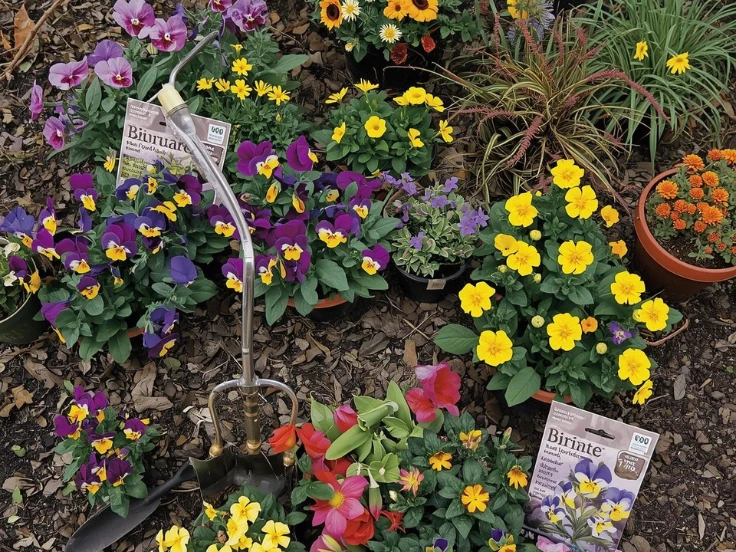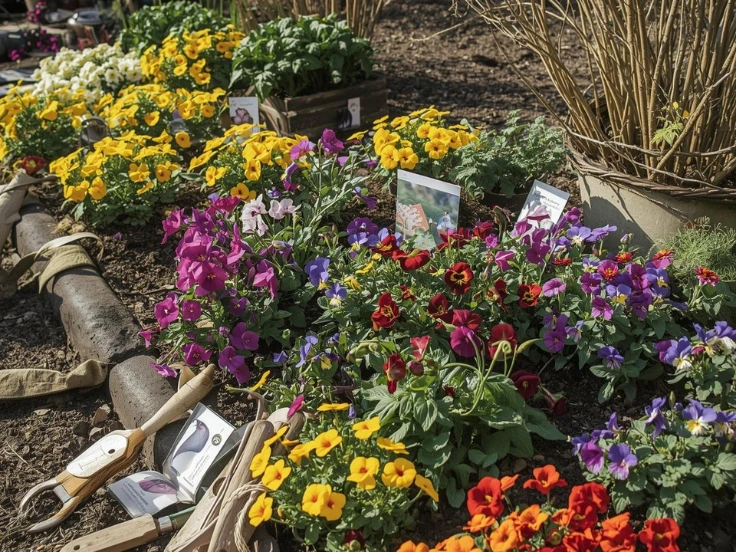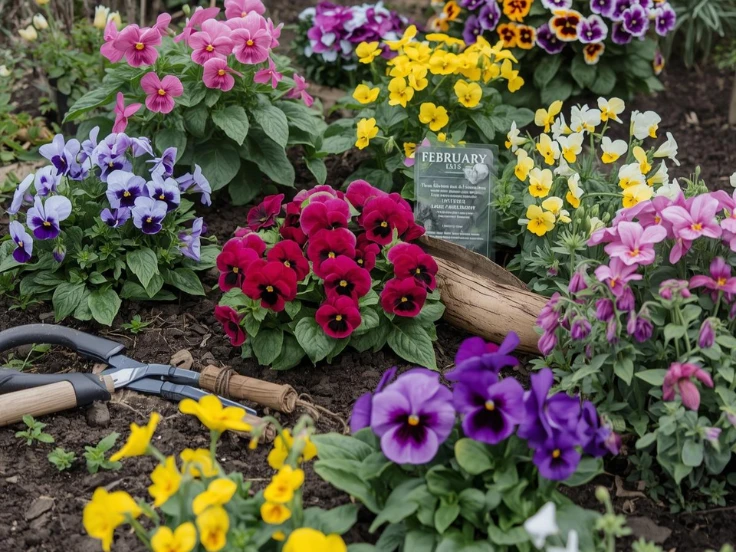February marks the transition from winter to early spring, making it the perfect time to start planting flowers. By choosing the right varieties, gardeners can ensure that their outdoor spaces will bloom beautifully as soon as the warmer months arrive. Understanding which flowers to plant in February is essential to create a vibrant and long-lasting garden display.
Early planting allows flowers to establish strong roots and survive late winter chills. Hardy varieties such as pansies, primroses, and early tulips can thrive in February conditions, giving your garden an early splash of color. Thoughtful selection of flowers also ensures continuous blooms as spring progresses.
Why February is Ideal for Planting Flowers

Planting flowers in February therefore has multiple advantages. The soil, while still cool, can be workable in milder regions, allowing gardeners to prepare garden beds and sow hardy seeds. Moreover, starting early gives plants a head start, ensuring robust blooms later in spring, while also providing time to address any winter garden issues.
Additionally, planting flowers in February attracts early pollinators and thus creates an early-season visual appeal. Furthermore, hardy perennials and shrubs planted now will thrive year after year, thereby adding long-term structure and beauty to your garden, while also enhancing overall biodiversity.
Choosing Hardy Flowers to Plant in February

When deciding which flowers to plant in February, it is crucial to focus on cold-tolerant and early-blooming varieties that can survive frost, while simultaneously adding color to your garden. For instance, popular choices include pansies, primroses, snowdrops, tulips, and violas, which not only brighten your outdoor space but also thrive in cooler conditions. Additionally, planting these flowers early ensures a head start for spring blooms.
-
Pansies: Frost-resistant and perfect for containers or beds.
-
Primroses: Bright, cheerful flowers that tolerate low temperatures.
-
Snowdrops: Early white blooms that signal the arrival of spring.
-
Tulips: Plant bulbs now for late March or April blooms.
-
Violas: Hardy and low-maintenance, suitable for borders and pots.
Selecting these flowers ensures that your garden flourishes even during unpredictable late winter weather.
Preparing Your Garden for February Planting
Before planting flowers in February, it is essential to properly prepare your garden, as this step is key to success. For instance, clearing debris, loosening soil, and adding compost not only improves soil health but also ensures that your flowers establish strong roots. Additionally, testing pH levels and planning the garden layout further enhances growth and visual appeal.
-
Clear debris: Remove weeds, leaves, and old plant material.
-
Loosen soil: Break up compacted areas to allow roots to grow freely.
-
Add compost: Enrich soil with nutrients for healthy plants.
-
Test pH: Aim for slightly acidic to neutral soil for most flowers.
-
Plan layout: Consider height, bloom time, and color for an appealing display.
Well-prepared soil increases survival rates and ensures your February-planted flowers thrive.
Popular Seeds to Sow in February
Sowing seeds indoors or in cold frames during February gives slow-germinating plants a head start. For example, some popular choices include snapdragons, sweet peas, calendula, lobelia, and alyssum, which not only prepare your garden for early blooms but also ensure a continuous display throughout spring. Additionally, starting seeds early allows gardeners to monitor growth and address any issues before transplanting.
-
Snapdragons: Start indoors, then transplant after frost.
-
Sweet Peas: Fragrant flowers that prefer cooler temperatures.
-
Calendula: Hardy and colorful, easy to grow.
-
Lobelia: Indoor sowing before moving outside.
-
Alyssum: Low-growing flowers perfect for borders or containers.
Starting seeds early ensures your garden will be full of blooms when spring arrives.
Bulbs to Plant in February

Indeed, bulbs are essential for early spring color. Moreover, planting bulbs such as tulips, daffodils, crocuses, and hyacinths in February therefore guarantees some of the first blooms of the season, while also providing low-maintenance beauty. Additionally, layering bulbs with early perennials ensures continuous visual interest in your garden.
Furthermore, layering bulbs with early perennials or annuals thereby ensures continuous visual interest. In addition, they require minimal maintenance, while also providing reliable and vibrant color in your February garden. Consequently, your garden will look lively and well-structured even during late winter.
Long-Term Benefits of Planting Perennials
Moreover, perennials planted in February add structure, longevity, and recurring beauty to gardens. Unlike annuals, they return each year, thereby providing vibrant color and texture, while also enhancing overall garden stability. Consequently, choosing perennials early ensures a more resilient and visually appealing garden.
-
Hellebores: Bloom in winter, thrive in shade.
-
Heucheras: Colorful foliage, perfect for borders.
-
Sedums: Drought-tolerant and hardy for early planting.
Staggered bloom times among perennials guarantee ongoing garden color and resilience.
Combining Flowers for a Colorful February Garden
Creating a successful February garden therefore involves balancing colors, textures, and heights. For instance, layer early blooms with ornamental cabbages, low-maintenance perennials, and small shrubs, which not only add visual appeal but also provide structure and diversity. Additionally, thoughtful placement ensures a harmonious and thriving garden throughout early spring.
-
Mix bright yellows, purples, and whites.
-
Place taller flowers at the back and shorter ones in front.
-
Consider fragrance near seating areas.
-
Use containers or window boxes for small spaces.
-
Plan succession planting for continuous blooms.
Thoughtful combinations enhance both visual appeal and garden health.
Indoor Flower Options for February
For gardeners in harsh climates, indoor flowers allow early enjoyment of blooms. February is perfect for forcing bulbs indoors or growing container flowers. Additionally, creating an indoor flower display brings color and fragrance into your home while protecting delicate plants from frost.
-
Amaryllis: Dramatic indoor blooms.
-
Cyclamen: Thrives in cooler indoor temperatures.
-
Orchids: Exotic flowers that bloom through winter months.
Indoor planting ensures vibrant flowers even during cold or snowy February days.
FAQs
Q: Can I plant flowers outdoors in freezing February weather?
A: Yes, choose hardy varieties and consider cold frames or mulch for protection.
Q: Which flowers bloom earliest when planted in February?
A: Snowdrops, hellebores, and pansies are typically the first to bloom.
Q: How often should I water seeds sown in February?
A: Keep soil moist but not soggy; frequency depends on indoor or outdoor conditions.
Q: Are bulbs suitable for February planting in all climates?
A: Mostly in mild to moderate climates; very harsh winters may require indoor pre-chilling.
Conclusion
Knowing which flowers to plant in February ensures your garden is prepared for a vibrant spring. Hardy flowers, bulbs, and perennials planted now establish strong roots, attract pollinators, and provide early color. For a complete guide on the best timing to plant flowers for spring, check out when to plant flowers for spring. Indoor planting options further extend your opportunities to enjoy blooms, even in cold months.
Gardening in February is a rewarding experience, offering both immediate beauty and long-term benefits. Thoughtful planting strategies, careful garden preparation, and flower selection allow you to enjoy early blooms, including stunning varieties like plants with large flowers, that rival the joy of exploring hidden gems in Hamburg places to visit.


















